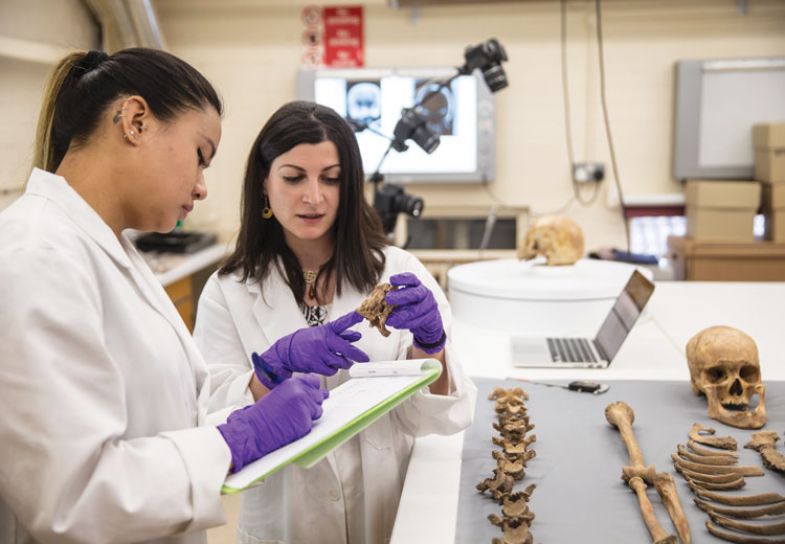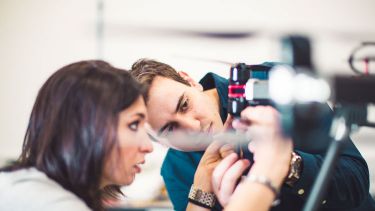
With a multimillion-pound investment in staff and equipment, Cranfield Forensic Institute is set to take its research and teaching to the next level
At Cranfield Forensic Institute (CFI), researchers and students are searching for the missing pieces of a puzzle. The application of science in criminal investigations can bring justice to victims, prevent terrorist attacks, and establish the line between guilt and innocence. Now, CFI, part of Cranfield University, is set to take its groundbreaking research to the next level. The university recently received £3.6 million from the South East Midlands Local Enterprise Partnership (SEMLEP) to match the investment made by the university. This allowed the institute to expand and invest in cutting-edge forensic equipment, teaching spaces and industry-relevant academic staff.
Cranfield Defence and Security, part of Cranfield University, is based at the Defence Academy of the UK in Shrivenham, Oxfordshire, where the university has been the academic provider of courses to the Ministry of Defence since 1984. Thanks to significant investment from the university and SEMLEP, this year CFI moved into three extensively renovated buildings at the Cranfield campus. Its new home will include state-of-the-art teaching spaces to house CFI’s work in digital forensics and a new course in investigative science, which supports the professionalisation of specialised policing roles.
The investment means CFI will be able to use specialist facilities at both the Cranfield campus in Bedfordshire and the Defence Academy of the UK in Oxfordshire. Andrew Shortland, professor of archaeological science and director of CFI, says the expansion is a “complete game-changer”. “There has been a huge investment in incredible teaching spaces and equipment aimed at research and teaching,” he explains.
CFI was established as the home for forensics-related disciplines, such as ballistics, explosives, archaeology and anthropology, security imaging, crime-scene investigation and digital forensics. Professor Shortland says the institute has three key aims: research, educating master’s and PhD students, and operational work.
“All our staff are expected to be research active,” Professor Shortland says. “We like our staff to be operational and to work on the real job – for example, with the police – in their area of expertise. We anticipate that our staff will do the job that a lot of our students want to do – not just talk about it or research it, actually do it.”
An academic who exemplifies this approach is Hannah Moore, a lecturer at CFI. One of two reporting forensic entomologists in the UK, Dr Moore combines her role with consulting for a forensic organisation. “You don’t get much notice when you’re called to a crime scene; it’s normally 24 hours. CFI are very good at releasing me,” she says. “I do the whole process, everything from collecting insect samples from human remains and the lab analysis to writing a statement and being an expert witness in court. When you’re teaching students, you’re delivering your experience back to them rather than teaching from a textbook. That operational side is something that very few universities can offer.”
With a background in chemistry, Dr Moore applies a chemical analysis technique to entomology. “I use the chemical profile, which is almost like a fingerprint, so I can identify the insects and I can age them [to establish the time of death],” she says. Professor Shortland’s focus is on analysing historical and archaeological objects, using scientific techniques to establish whether an art object is genuine, a later copy or fake.
Other notable projects at CFI include Dr Nicholas Márquez-Grant’s involvement in the search for the human remains of those who were executed in central Spain during the Francoist regime. Professor Andrew Silke, meanwhile, has research interests that include the prison radicalisation of terrorists, and Professor Keith Rogers is investigating new X-ray techniques to improve the efficacy of airport baggage scans. Staff and students, such as those researching forensic ballistics, also have access to an armoury and explosives ranges at the Defence Academy in Shrivenham and on Salisbury Plain.
Dr Moore says that with such a wide range of research areas, CFI has a stimulating and collaborative working culture. “We’re very supportive of each other, whether that’s in research or teaching. We look at very niche areas and we are very passionate about what we do,” she says. “I can’t see myself working at any other university because of both the research and the operational freedom.”
In an environment where research is actively encouraged, there is no shortage of innovation. “It’s not only the innovation involved in thinking of new ideas, but Cranfield as a university specialises in taking those ideas and putting them into industry and creating a final product that works,” says Professor Shortland. “We’re lucky that we work within a university which is one of the best in Europe at taking ideas, applying science and being able to put them into action.”
Researchers are encouraged to collaborate with other universities and organisations. CFI partners with some of the world’s top universities, including Oxford, Harvard and Northwestern. Industry partners are similarly prestigious; Dr Moore is working with the Natural History Museum, and Professor Shortland collaborates with the Metropolitan Police’s Art and Antiques Unit and auction houses including Bonhams, Sotheby’s and Christie’s. Other partners include the US-based Defense POW/MIA Accounting Agency, which identifies missing military personnel who have been unaccounted for since the Second World War.
With its new investment, CFI is on a recruitment drive with five academics already recruited and another four positions to fill. They include two posts in the digital forensic facility and two in crime-scene investigation. Professor Shortland says the new hires, like the institute’s existing staff, would need to combine research, teaching and scholarship activities with an operational role. “They may not have experience in all these areas because they may come to us through the police, for example, and they haven’t had the opportunity. However, we are looking for people who should have the drive, enthusiasm and ability to excel in these different roles.”
With a proud history of providing the next generation of forensic experts, the CFI is seeing growing demand from students. Last year, despite the pandemic-enforced lockdown, a record number of students joined its forensic programmes. “I think students are starting to switch and actively go for the courses with that strong scientific foundation,” says Dr Moore. “The course is accredited by the Chartered Society of Forensic Sciences, and to give themselves that extra edge, they’re needing the master’s to get their foot in the door in the industry.”
Looking to the future, Professor Shortland believes CFI is well placed to lead the charge to improve the quality and breadth of forensic science research. A recent House of Lords report found the UK was weak in fundamental research in forensic science and applying it in a court context. “We’d like to be a national facility for forensic science research,” says Professor Shortland. “Universities, the government and the country need this research.”
Find out more about CFI.



